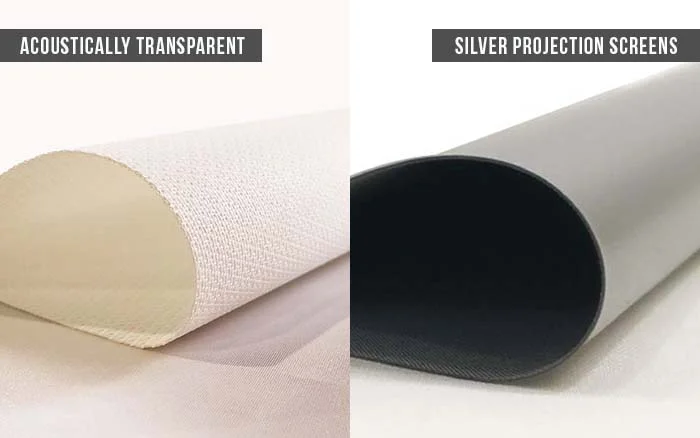
So, how do projector screen fabrics differ?
For corporate offices, home theatres, and auditoriums, a variety of projector screen fabrics are available. A lot of consideration goes into choosing the style, size, and price range of the projector screen. You must choose the ideal projector screen fabric after deciding on the style and mechanism of your type of screen.
The resolution of the media being utilized, the lighting and acoustics, and the audience’s viewing angle all affect how well different screen fabrics perform in various applications and circumstances. Choosing the best fabric for your device is made easier by knowing the function of screen fabric and the varieties that are available, despite the fact that this topic may appear confusing. Let’s examine the various projector screen fabric textiles that you should take into account before choosing and purchasing one.
Matte Screens: For dark rooms and shady places
The most popular front projector screen fabric in the market has a matte surface and is called Matte White. In addition, the majority of projectors that you may obtain have been customized to function with this kind of content. In dark environments, such as those seen in movie theatres, matte white screens with 1.0 gain produce the finest images. They can also function effectively in spaces with minimal natural light.
Occasionally, they may produce a decent image even in well-lit spaces, but only if the light is not shining directly on the screen. These displays are frequently used for gaming, viewing movies at home, and in theatres. The majority of customers desire their vibrant hues and well-balanced contrast.
Silver Projector screen fabric: Darker Images in well-lit rooms!
When it is necessary to give darker pictures, (Grey Screens), a matte silver projector screen fabric with a lower gain of 1.0, is used. They may also be used in highly bright spaces, as well as in large auditoriums, conference centers, and meeting rooms with bright lighting.
These displays are excellent for playing games with multiple dark levels as well as viewing movies.
How do they work though?
Utilizing the non-linear perception of brightness in the human eye, (Grey Screens) are made to rely on strong projections that can create sufficient levels of luminance such that the white regions of the image still appear to be white.
Thus, a grey screen may give an image that appears brilliant almost as good as a white screen. The category of high-gain screens includes the silver projector screen fabric, which has a gain value of 1.5.
This material is capable of illuminating extremely dark pictures, and it frequently works well when projecting 3D images. They can never be used with short-throw projections, but they perform fantastically with high-lumen, low-contrast ones.
Acoustically Transparent: Screens that allow sound to pass through
An acoustically transparent screen comes in two major varieties: woven and perforated.
Woven Screens: The most preferred
A projector screen fabric that is woven is created on a loom, and the woven effect naturally varies the pattern and spacing on the screen. A highly accurate diagonal angle should be used for the weaving design.
Compared to a perforated screen, a woven projector screen fabric often allows sound to travel through more easily. When it comes to acoustical transparency, the majority of individuals think woven screens are superior to perforated screens.
What are the challenges that come with it?
The equalization of the speakers can be changed to prevent certain frequencies from being absorbed into the screen. In general, woven projector screen fabric are doing a decent job of keeping light from flowing through the screen while allowing sound to get through.
Possible issues which can occur with low-quality Woven Screens
- Poor Colour Temperature
- Moire Effect
- Double Imaging
Perforated Screens: Durability at its finest
A very durable material with thousands of minute perforations makes up a perforated projector screen fabric. (The term “perforated” refers to making a hole or holes in anything.)
In essence, the material has had a large number of holes punched in it, allowing sound to travel through the screen. With holes that are often smaller than 3mm in diameter, the material is normally composed of extremely durable PVC.
A perforated screen makes it less likely that you will see a double image since light does not travel through it very well.
Possible issues which can occur with low-quality Perforated Screens
- Moire Effect
- Less effective acoustic transparency
Lumina Screens: Quality at its finest
Such problems won’t be your worry any more thanks to Lumina projector screens. Premium woven projector screen fabric called Accupix and Accupix Pro are generally utilized for mounting behind speakers. The projection screens include SDR, the most recent advancement in fabric design that is exclusive to Lumina Screens. SDR is a special weaving pattern that diffuses sound to improve the clarity and quality of the music. Since the speakers cannot be seen through the projection surface when seen from the front and do not reflect any light back through it, there is no visual distortion. This is made possible using SDR technology.
Compared to other projector screen fabrics on the market, it is a big advantage.
In Conclusion
Understanding the requirements for each project and getting advice from a technologically advanced projector screen fabric business like Lumina Screens are the keys to creating an immersive home-watching experience.
- Date - February 20, 2020